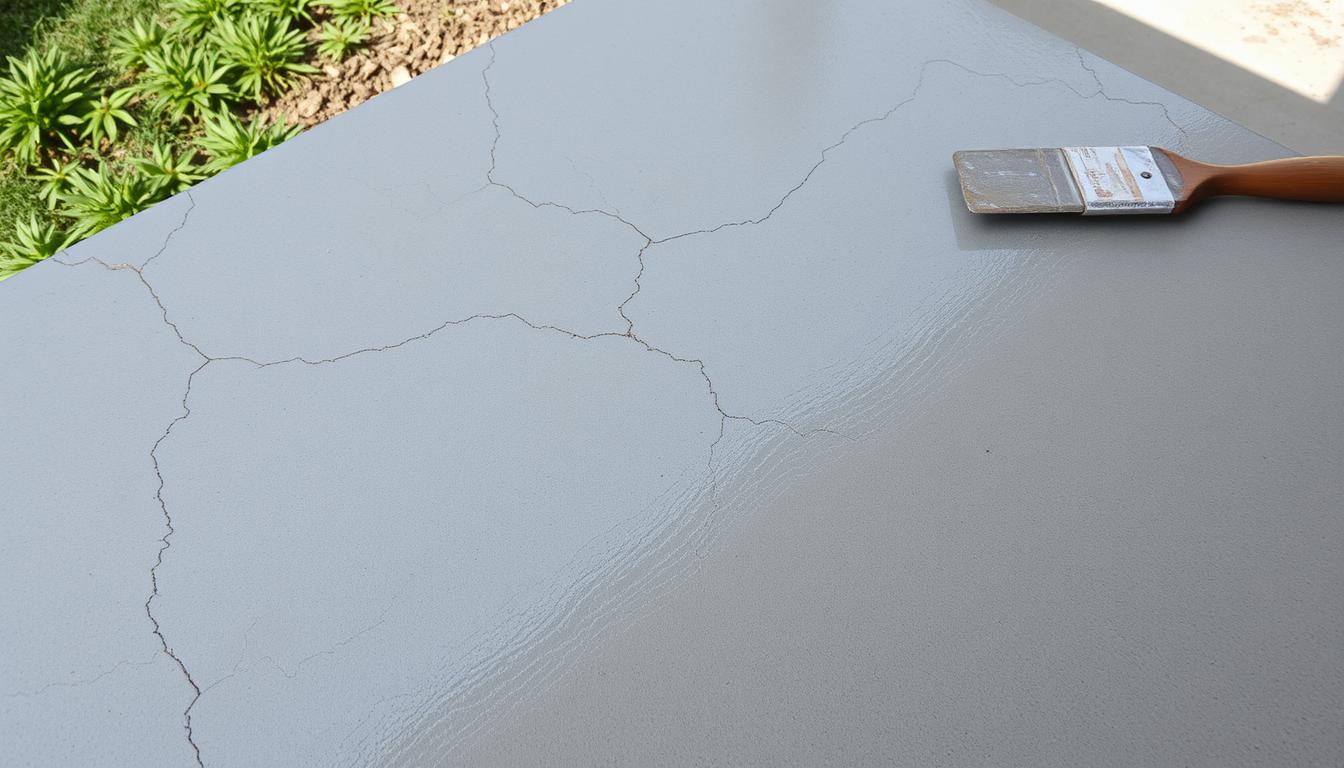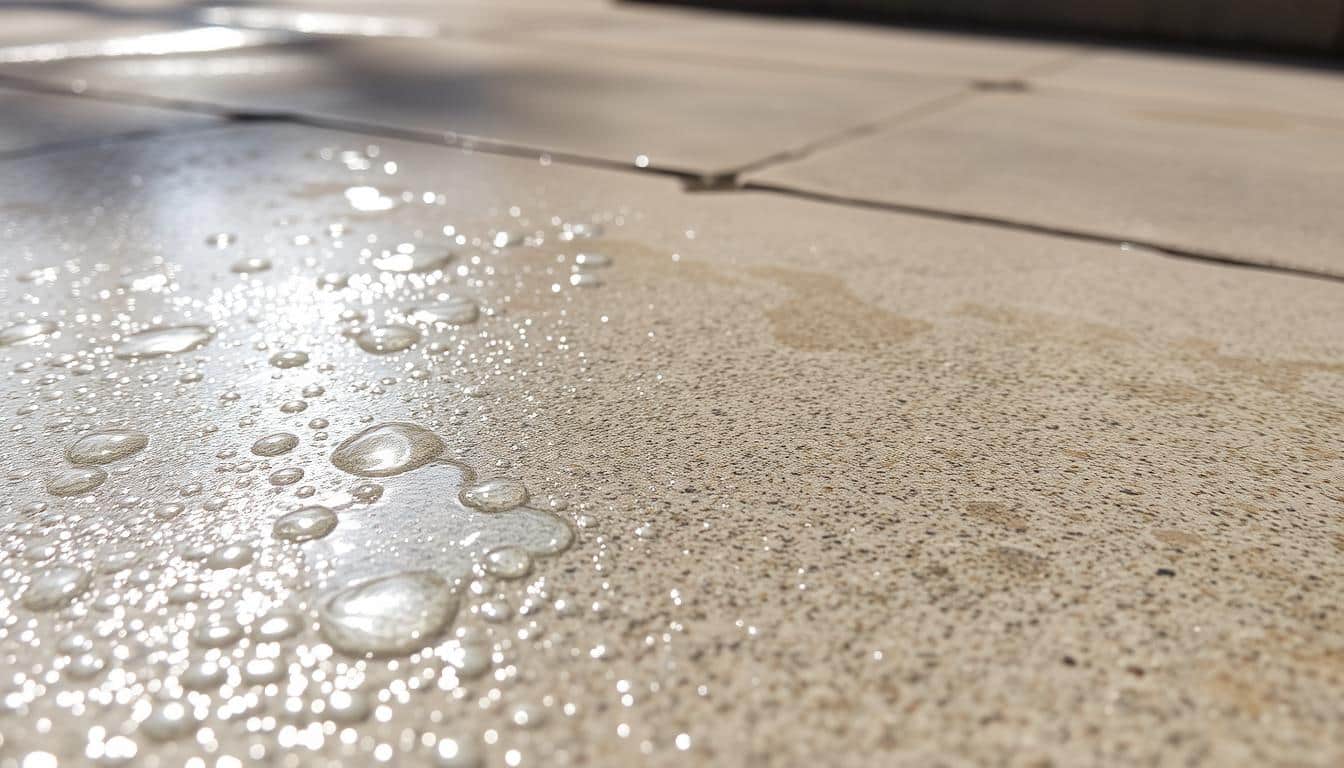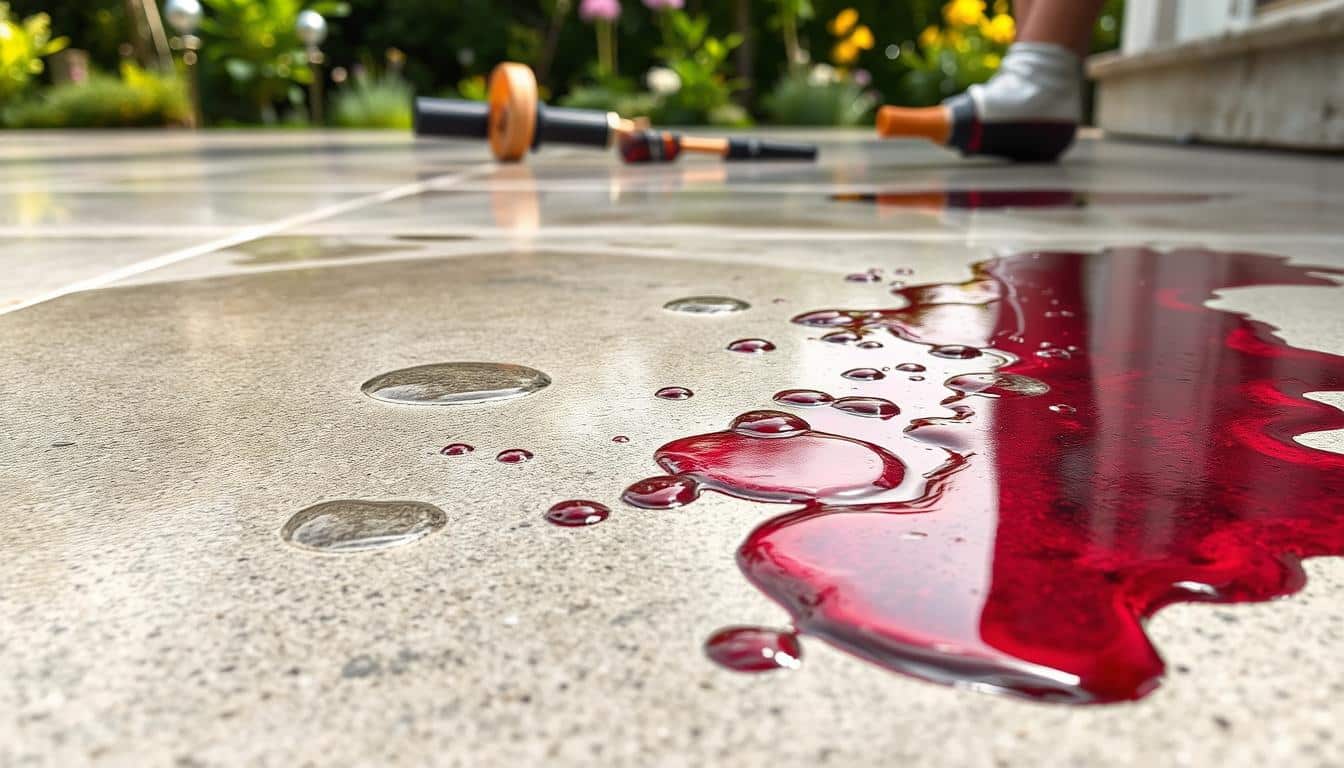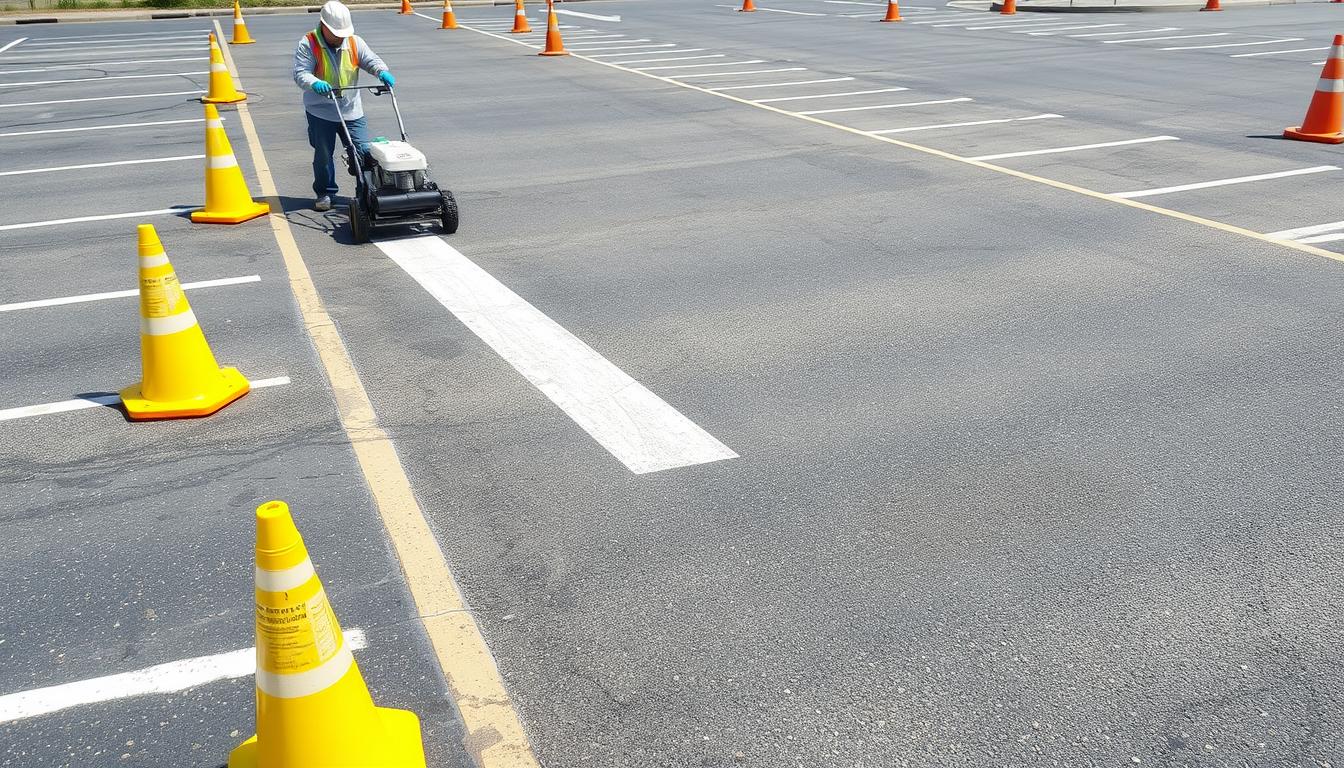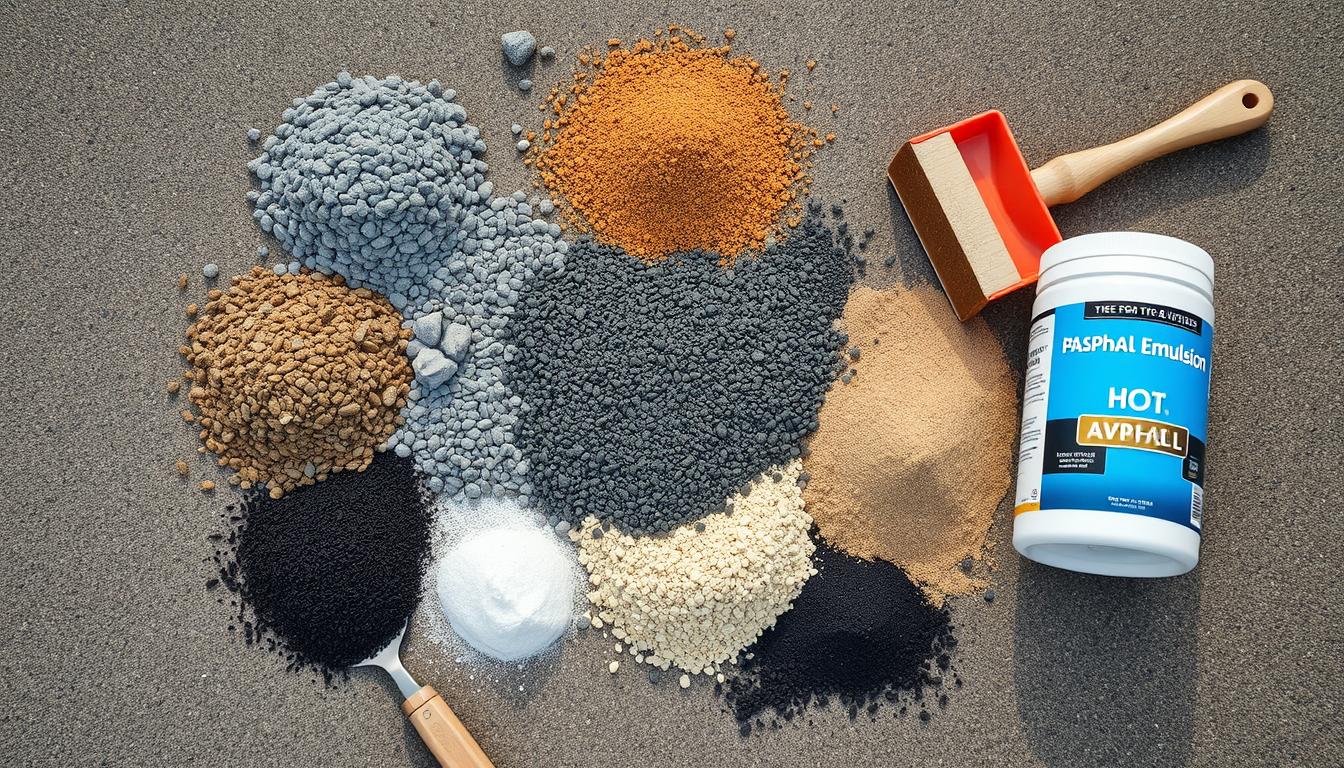Ever wondered how long concrete sealer takes to cure? Knowing this is key for keeping your concrete looking good and lasting long. The curing time varies, from 24 to 72 hours, depending on the sealer type, weather, and how thick it’s applied.
Understanding the concrete sealer curing time is important for your investment. It helps protect your concrete from moisture and UV rays. The concrete sealer drying time changes with the type of sealer you use. Water-based, solvent-based, or epoxy sealers each have their own drying needs. Ready to learn more about curing times? Let’s explore further.
Key Takeaways
- Concrete sealers typically cure in 24 to 72 hours depending on several factors.
- Water-based sealers require 1 to 3 hours to be touch dry, while solvent-based sealers take 4 to 12 hours.
- Epoxy sealers may require up to 7 days for complete curing.
- Ideal temperature ranges significantly impact curing times for all types of sealers.
- Common signs of uncured sealant include tackiness, imprint transfer, and lingering odors.
- Correct curing is essential to avoid long-term damage and the need for reapplication.
- For optimal results, professional services like those from HT Paving and Seal Coating can be invaluable.
Understanding Concrete Sealers
A concrete sealer is like a shield for concrete surfaces. It makes them last longer and look better. Knowing the different types helps you pick the best one for your needs and where you live.
What is Concrete Sealer?
A concrete sealer is a special coating that keeps moisture, stains, and weather out. It goes deep into the concrete to create a strong barrier. Using a good sealer can make concrete last a lot longer.
Types of Concrete Sealers
There are many kinds of concrete sealers, each for a different use. Acrylic sealers are good for decorative concrete and are easy on the wallet. Epoxy and urethane sealers are stronger and great for places that get a lot of foot traffic. Penetrating sealers are best for areas that face harsh conditions, creating a strong internal shield. Each type has its own special features for different needs and places.
Benefits of Using Concrete Sealers
Concrete sealers have many advantages. They stop moisture from getting in, which can cause cracks and damage. They also fight off weathering, keeping the concrete looking new. Plus, they prevent stains, keeping your concrete looking good, like on driveways and patios. Choosing the right sealer means your concrete will last longer and look better.
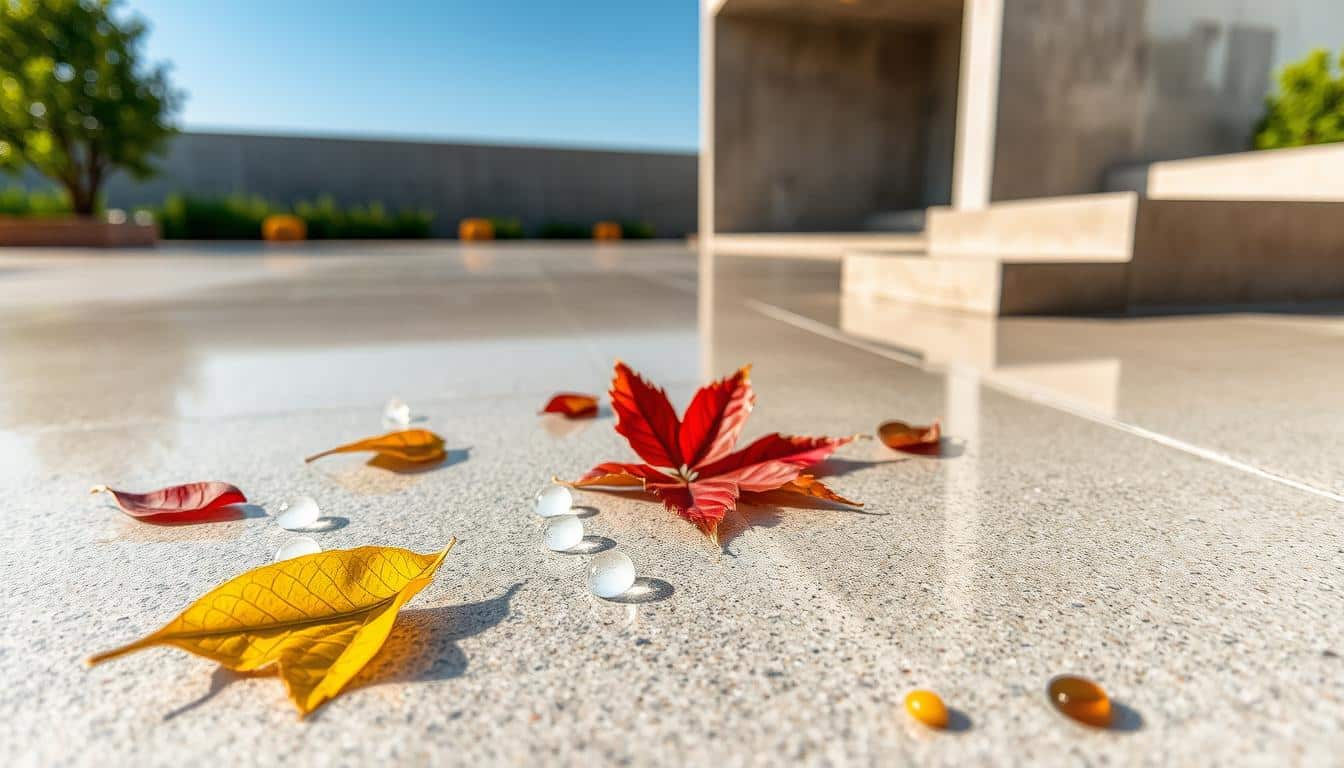
Factors Affecting Curing Time
Several factors influence how long it takes for concrete sealers to cure. Knowing these can help ensure the job is done right and lasts long. Temperature and humidity are key in the drying process. Also, the type of sealer and how thick it is applied affect curing speed.
Temperature and Humidity
Temperature and humidity are critical in curing concrete sealers. The best curing temperatures are between 55°F and 90°F. Higher temperatures speed up the curing process.
Low humidity, below 50%, helps dry the surface faster. But high humidity slows it down. Sunlight can make curing quicker than shade, which may take longer.
Type of Sealer Used
The type of sealer used also impacts curing time. Acrylic sealers dry in about 2 hours under the right conditions. They’re great for quick jobs.
On the other hand, coal tar emulsions take up to 24 hours to dry because they’re thicker. Choosing the right sealer for your project’s timeline and environment is key.
Thickness of Application
How thick you apply the sealer affects the curing time. Thicker layers take longer to dry. Using thin coats instead of one thick layer can speed up the process.
Checking the weather before applying sealer is important. It helps avoid delays and ensures the job is done right.
Typical Curing Times for Concrete Sealers
Curing times for concrete sealers vary a lot. This depends on the type of sealer and the environment. Knowing the typical curing times is key to getting the best results and making the sealed surface last longer.
Acrylic Sealers
Acrylic sealers dry fast. They usually dry to the touch in 1-4 hours. But, for areas where vehicles and heavy use are common, it’s best to wait 24-48 hours for full curing. These sealers protect well against moisture and UV rays, making them great for driveways.
Epoxy Sealers
Epoxy sealers take longer to cure. They dry in 10-12 hours, but reach full strength in up to 72 hours. This sealer is tough, perfect for places with heavy loads or lots of foot traffic.
Polyurethane Sealers
Polyurethane sealers cure quickly, drying in 5-12 hours. They’re great for busy areas because they dry fast. Using these sealers helps protect against moisture and daily wear, making concrete surfaces last longer.
Importance of Proper Curing
Proper curing of concrete sealers is key to their long-lasting performance. It ensures the surface stays effective over time. Homeowners and builders gain many benefits from this process.
Enhancing Durability
Proper curing is vital for durability. It creates a strong barrier against moisture, temperature changes, and heavy traffic. Without enough curing, surfaces can crack or flake early.
So, spending time on curing extends the concrete’s life and keeps it strong.
Preventing Damage
Insufficient curing causes many problems. It makes concrete more porous and weaker. These issues can lead to expensive repairs and resurfacing.
By curing properly, you avoid these risks and get a durable surface.
Aesthetic Considerations
The look of concrete surfaces also depends on curing. Bad curing can cause uneven finishes and color issues. Proper curing ensures the surface looks as good as it should.
This makes the finished product more attractive, boosting property value.
Signs Your Concrete Sealer is Cured
Knowing when your concrete sealer is cured is key to its long-term success. Look for visual signs to see if it’s ready. Touch tests and watching specific times also help confirm its readiness.
Visual Indicators
A uniform finish is the first sign of a cured sealer. It should look clear and even, without cloudy or sticky spots. If you used a topical sealer, it should have a glossy look. This not only looks good but also means it’s cured well.
Touch Tests
One way to check if a sealer is cured is by touching it. It should feel dry and firm, not sticky. If it’s sticky, it’s not ready yet. Wait until it’s completely dry before using it.
Timeframes to Watch For
Knowing when to wait is key for a cured sealer. Sealers usually take 24–72 hours to cure fully. Water-based ones dry faster, in 2–4 hours. Solvent-based ones take 4–6 hours.
New concrete needs at least 28 days to cure before sealing. Following these times helps avoid damage and keeps the surface looking good.
How to Ensure Proper Curing Conditions
To get the best out of concrete sealers, focus on a few important things. First, understand the role of weather. Then, control the environment and prepare the site properly.
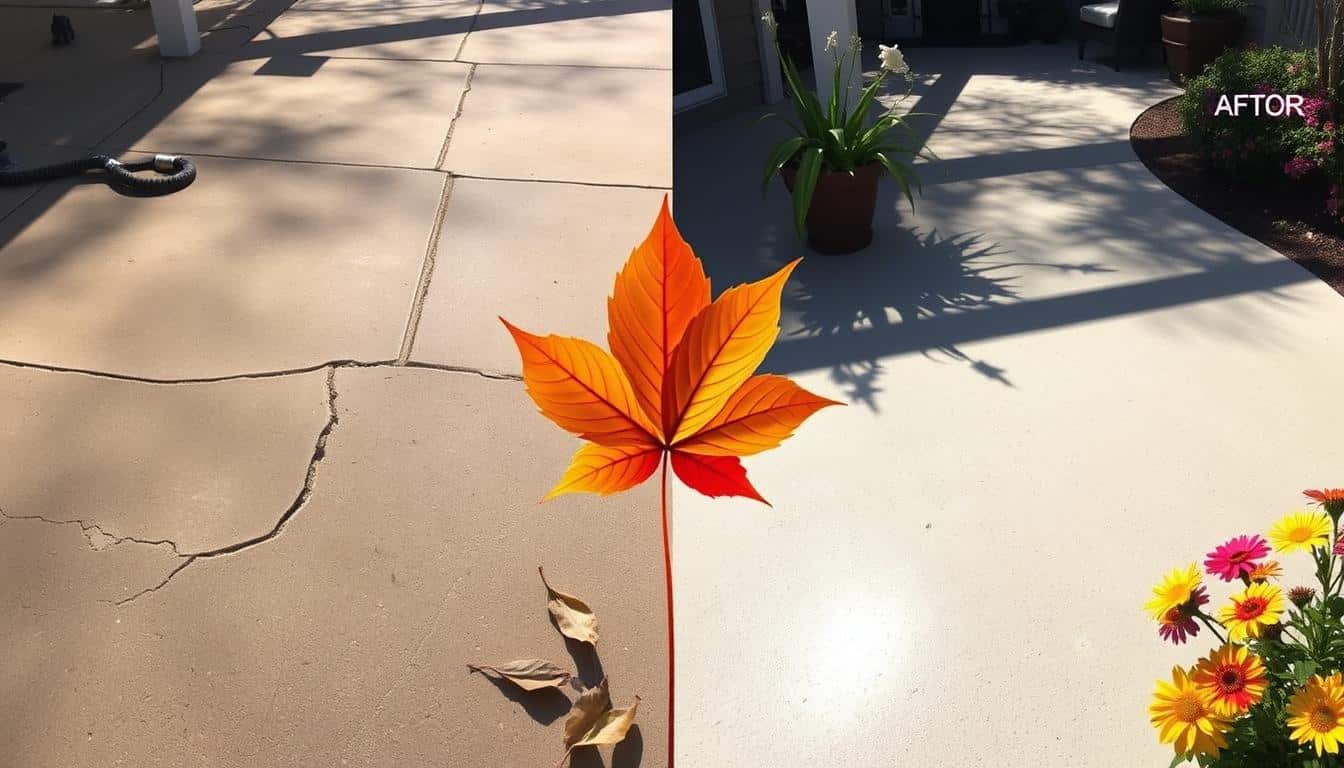
Optimal Weather Conditions
The right weather is key for sealing concrete. Temperatures between 55°F and 75°F are ideal. Also, humidity should be below 55% to speed up drying and improve adhesion.
Environmental Control
It’s important to control the environment when sealing concrete. Protect it from rain, direct sunlight, and extreme temperatures. These can slow down the curing process. If it’s too humid or rainy, you might need extra steps to keep the environment right.
Site Preparation Techniques
Good site preparation is essential for sealing success. Clean the concrete well and make sure it’s smooth. This helps the sealer stick better. If there’s dirt or debris, it can slow down curing. By doing these steps, you can make the sealer last longer and look better.
Mistakes to Avoid During the Curing Process
Concrete sealing needs careful attention. Common mistakes can greatly affect how well sealers work. One big error is sealing too soon after pouring the concrete. This can trap moisture, causing bubbles or peeling. These issues harm the concrete’s look and durability.
Applying Too Soon
Sealing concrete too quickly can make it tacky. This mistake can ruin up to 20% of DIY projects. Waiting 24 to 72 hours before sealing helps the sealer stick better and avoids big problems.
Neglecting Weather Reports
Not checking the weather before sealing can cause big issues. Changes in temperature and humidity can lead to 15% of curing failures. Always look at the weather forecast to seal when it’s best. This helps avoid problems caused by bad weather.
Over-application of Sealer
Using too much sealer can leave clouds or streaks, affecting nearly 10% of DIY projects. It’s important to follow the sealer’s application guidelines. This ensures the right amount is used and prevents problems.
HT Paving and Seal Coating Services: Your Local Experts
HT Paving and Seal Coating Services is a top family-owned business in the Bay Area. We specialize in concrete and asphalt solutions for homes and businesses. Our team is committed to providing top-notch service and expertise in every project.
About Us
We at HT Paving and Seal Coating Services are all about quality. We aim to make pavements last longer. Our work shows our dedication to precision and customer happiness. We’re certified and meet our clients’ needs in California.
Our Mission and Values
Quality and reliability are our top priorities at HT Paving and Seal Coating Services. We focus on sustainable practices and support our clients fully. Building strong relationships with our customers is what we value most.
Contact Information: (415) 774-6424
Want to know more about how we can help? Call us at (415) 774-6424. Our team is eager to talk about your paving needs and find the best solutions for you.
FAQs About Concrete Sealer Curing
Many people have questions about concrete sealer curing. They worry about what happens after they apply it, mainly when the weather is not good. Here are some common questions and answers to help clear things up.
What if it rains after sealing?
If it rains right after you seal, the moisture can mess up the curing. Always check the weather forecast before sealing. It’s best to wait 24-72 hours for the sealer to cure before any rain comes.
Can I walk on the surface before it’s cured?
It’s not a good idea to walk on newly sealed concrete too soon. You should wait at least 4 to 5 hours for it to dry a bit. It might take up to 3 days for it to fully cure. Walking on it too early can damage the seal and lead to costly repairs.
How can I tell if the sealer is working?
To check if the sealer is working, look for a shiny surface. Also, see if water just beads up and doesn’t soak in. This shows the sealer is doing its job.
Following these tips can help ensure your concrete sealing is a success.
Final Thoughts on Concrete Sealer Curing Times
Knowing how long concrete sealers take to cure is important. It keeps your concrete looking good and lasting long. Different sealers cure at different times, and weather affects this too.
Waiting the right amount of time lets sealers work best. They protect your concrete from water, chemicals, and wear.
Quick Review of Key Points
It usually takes about 24 hours before you can walk on sealed concrete. But, full curing can take days, depending on the sealer and weather. For example, acrylic sealers dry fast, while polyaspartic sealers dry even quicker.
Also, getting professional help is important. It ensures your concrete is well-protected for years.
Importance of Professional Services
Hiring experts for your concrete sealing is a smart move. They know how to apply sealers correctly and use the best products for your concrete. This prevents mistakes that can happen with DIY or amateur jobs.
Call to Action: Reach Out to HT Paving Today
For the best sealing services, contact HT Paving. They know all about concrete sealer curing times and how to apply them. This way, you can keep your concrete looking great for a long time. Don’t wait—call them today for professional service.
